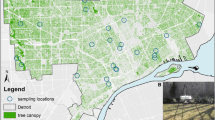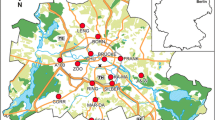Abstract
The French airborne pollen monitoring network (RNSA) is currently regrouping 70 Hirst-type pollen traps covering the whole French territory. The aim of this paper is to introduce a simple statistical methodology that can be used to characterize pollen spatial variation. This pilot study is restricted to a limited portion of the RNSA network (18 monitoring stations), eight taxa of allergenic relevance, and a 3-year period (2003–2005). The first step of the approach consisted in quantifying the trap-to-trap pollen similarities on the basis of an original index, called mean Pollinic Distance (mPD), that relies on the comparison of pollen concentration time series. Regression analyses were next conducted with different spatial variables. Distance, latitude and altitude differences were identified as significant predictors of pollen variations, as measured by mPD. In order to further characterize pollen spatial properties, cluster analysis was performed with mPD as the distance estimate. Interestingly, the clusters of sites identified on the basis of the similarity of their pollen profiles, correspond to distinct geographic areas that might be interpreted as homogeneous air masses. The results have major implications for monitoring networks management since they provide an objective basis (1) for choosing the relevant scale to elaborate and supply pollen-related information, and (2) for optimizing networks configuration.






Similar content being viewed by others
Notes
This spatial domain would include St Etienne, Lyon, and Roussillon.
The area of coverage of a Hirst-type pollen trap is usually considered to be a disk, and 50 km is an often cited figure for its diameter. It is interesting to compare this value to results presented in Fig. 4a showing that at around this distance criterion mPD values range from 0.32 (Chalon-sur-Saône–Dijon; similar pollen properties) to 0.65 (Lyon–St Etienne; strongly different profiles) clearly indicating that this figure has to be used with some caution.
Abbreviations
- MPD:
-
Mean Pollinic Distance
- PD:
-
Pollinic Distance
- RNSA:
-
French Airborne Pollen Monitoring Network (Réseau National de Surveillance Aérobiologique)
References
Belmonte, J., & Canela, M. (2002). Modelling aerobiological time series: Application to Urticaceae. Aerobiologia, 18, 287–295.
Besancenot, J. P., Sulmont, G., Laaidi, M., & Thibaudon, M. (2003). The French airborne pollen network: Current situation and prospects for improvement. Allergie et immunologie (Paris), 35, 158–163.
Calleja, M., Farrera, I., Almeras, T., Richard, P., Rossi, O., Vernier, D., Belmonte, J., Puigdemont, R. & Plaisant, I. (2005) Métrologie des pollens dans l’air: Étude intercomparative en région Languedoc-Roussillon. Rapport final. Etude DRASS Languedoc-Roussillon, 2005.
Cleveland, W. S., & Devlin, S. J. (1979). Locally weighted regression: An approach to regression analysis by local fitting. Journal of the American Statistical Association, 83, 596–610.
Comtois, P. (1994). Airborne pollen dispersal and survival on Mount Sutton (Canada). Aerobiologia, 10, 31–37.
DeGaetano, A. T., & Doherty, O. M. (2004). Temporal, spatial and meteorological variations in hourly PM2.5 concentration extremes in New York City. Atmospheric Environment, 38, 1547–1558.
Emberlin, J., Jaeger, S., Dominguez-Vilches, E., Soldevilla, C., Hodal, L., Mandrioli, P., Lehtimäki, A., Savage, M., Spieksma, F., & Bartlett, C. (2000). Temporal and geographical variations in grass pollen seasons in areas of western Europe: An analysis of season dates at sites of the European pollen information system. Aerobiologia, 16, 373–379.
Gehrig, R., & Peeters, A. G. (2000). Pollen distribution at elevations above 1,000 m in Switzerland. Aerobiologia, 16, 69–74.
Ibarra, G., Alonso, L., Navazo, M., Elias, A. & Gangoiti, G. (1994). Application of cluster analysis in optimization process of surface meteorological and air quality networks. In The 2nd international conference on air pollution. Part 1 (of 2), (pp. 515–522). Barcelona, Spain.
Ito, K., De Leon, S., Thurston, G. D., Nadas, A., & Lippmann, M. (2005). Monitor-to-monitor temporal correlation of air pollution in the contiguous US. Journal of Exposure Analysis and Environmental Epidemiology, 15, 172–184.
Martuzevicius, D., Grinshpun, S. A., Reponen, T., Gorny, R. L., Shukla, R., Lockey, J., Hu, S., McDonald, R., Biswas, P., & Kliucininkas, L. (2004). Spatial and temporal variations of PM2.5 concentration and composition throughout an urban area with high freeway density-the greater Cincinnati study. Atmospheric Environment, 38, 1091–1105.
Martuzevicius, D., Luo, J., Reponen, T., Shukla, R., Kelley, A. L., St Clair, H., & Grinshpun, S. A. (2005). Evaluation and optimization of an urban PM2.5 monitoring network. Journal of Environmental Monitoring, 7, 67–77.
Monn, C., Carabias, V., Junker, M., Waeber, R., Karrer, M., & Wanner, H. U. (1997). Small-scale spatial variability of particulate matter <10 μm (PM10) and nitrogen dioxide. Atmospheric Environment, 31, 2243–2247.
Morawska, L., Vishvakarman, D., Mengersen, K., & Thomas, S. (2002). Spatial variation of airborne pollutant concentrations in Brisbane, Australia and its potential impact on population exposure assessment. Atmospheric Environment, 36, 3545–3555.
Noble, C. A., Mukerjee, S., Gonzales, M., Rodes, C. E., Lawless, P. A., Natarajan, S., Myers, E. A., Norris, G. A., Smith, L., & Ozkaynak, H. (2003). Continuous measurement of fine and ultrafine particulate matter, criteria pollutants and meteorological conditions in urban El Paso, Texas. Atmospheric Environment, 37, 827–840.
Norton, D. A., McGlone, M. S., & Wigley, T. M. L. (1986). Quantitative analyses of modern pollen-climate relationships in New Zealand indigenous forests. New Zealand Journal of Botany, 24, 331–342.
Pinto, J. P., Lefohn, A. S., & Shadwick, D. S. (2004). Spatial variability of PM2.5 in urban areas in the United States. Journal of the Air & Waste Management Association, 54, 440–449.
Raffuse, S. M., Sullivan D. C., McCarthy, M. C., Penfold, B. M., Hafner, H. R. (2007). Ambient air monitoring network assessment guidance, analytical techniques for technical assessments of ambient air monitoring networks. Retrieved July 20, 2007, from U.S. environmental protection agency web site: http://www.epa.gov/ttn/amtic/files/ambient/pm25/datamang/network-assessment-guidance.pdf.
Rodriguez-Rajo, F. J., Dopazo, A., & Jato, V. (2004). Environmental factors affecting the start of pollen season and concentrations of airborne Alnus pollen in two localities of Galicia (NW Spain). Annals of Agricultural and Environmental Medicine, 11, 35–44.
Sabaton C. (1976), Etude d’optimisation d’un reseau de surveillance de la pollution atmospherique dans la region Parissienne. In M. M. Benarie (Eds), Atmospheric pollution (pp. 159–171). Amsterdam: Elsevier.
Saksena, S., Joshi, V., & Patil, R. S. (2003). Cluster analysis of Delhi’s ambient air quality data. Journal of Environmental Monitoring, 5, 491–499.
Sánchez-Mesa, J. A., Smith, M., Emberlin, J., Allitt, U., Caulton, E., & Galan, C. (2003). Characteristics of grass pollen seasons in areas of southern Spain and the United Kingdom. Aerobiologia, 19, 243–250.
Seron Arbeloa, F. J., Perez Caseiras, C., & Latorre Andres, P. M. (1993). Air quality monitoring: Optimization of a network around a hypothetical potash plant in open countryside. Atmospheric Environment Part A, General Topics, 27, 729–738.
Silva, C., & Quiroz, A. (2003). Optimization of the atmospheric pollution monitoring network at Santiago de Chile. Atmospheric Environment, 37, 2337–2345.
StatSoft (2006). Electronic statistics textbook. Tulsa, Okla.: StatSoft. Retrieved July 20, 2007, from http://www.statsoft.com/textbook/stathome.htlm
Wilson, J. G., Kingham, S., Pearce, J., & Sturman, A. P. (2005). A review of intraurban variations in particulate air pollution: Implications for epidemiological research. Atmospheric Environment, 39, 6444–6462.
Wongphatarakul, V., Friedlander, S. K., & Pinto, J. P. (1998). A comparative study of PM2.5 ambient aerosol chemical databases. Environmental Science & Technology, 32, 3926–3934.
Zanotti, A. L., & Puppi, G. (2000). Phenological surveys of allergenic species in the neighbourhood of Bologna (Italy). Aerobiologia, 16, 199–206.
Acknowledgments
We wish to thank Bernard Clot, Jean-Pierre Besancenot, and Paul Comtois for assistance with drafting the manuscript and the anonymous referees for providing very helpful comments. We are grateful to MeteoSwiss for allowing the use of the data collected in Geneva. This research has benefited from the financial support of ADEME (Agence de l’Environnement et de la Maîtrise de l’Energie).
Author information
Authors and Affiliations
Corresponding author
Rights and permissions
About this article
Cite this article
Rieux, C., Personnaz, MB. & Thibaudon, M. Spatial variation of airborne pollen over south-east France: characterization and implications for monitoring networks management. Aerobiologia 24, 43–52 (2008). https://doi.org/10.1007/s10453-007-9081-z
Received:
Accepted:
Published:
Issue Date:
DOI: https://doi.org/10.1007/s10453-007-9081-z




